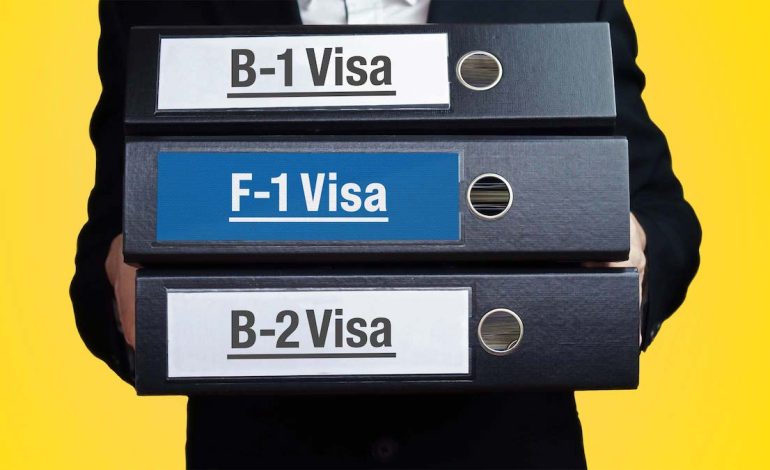Despite recent controversial visa limits, the United States remains one of the world’s top foreign student destinations. The allure of the United States to international students is its diverse range of study programs and universities, top-ranked degrees, well-equipped laboratories, considerable PhD financing, and the opportunity to learn about cultures from throughout the world.
Because of new American immigration laws as well as the global Coronavirus outbreak, visa regulations have changed and may be more complicated, but this should not deter you from following your ambition of studying abroad. So, let’s go over the primary actions you’ll need to complete to obtain your US F1 visa.
Read Also: How to Convert B1 B2 Visa to F1 Visa?
To even apply for an F1 visa, you must meet certain requirements, such as:
- Get admitted into a SEVP accepted institution. The Student Exchange Visitor Program (SEVP) has a list of schools, universities, and other institutions which meet the conditions and accept international students. It is recommended that before applying to your preferred schools or universities, you should first check the SEVP and see if those institutions are listed there. If yes, you can proceed to send them any documents that they require to make an admission decision. If not, you should not apply since you will not get the student visa even if you are accepted into the school.
- Be enrolled as a full-time student.
- Have strong ties to your home country. If you don’t prove and submit documents that you have strong ties to your home country and intend to go home after your educational program ends, it will be more difficult to get an F1 visa.
- Proof financial sufficiency. You should prove that you have sufficient funds in your bank accounts to cover the expenses of studying and living in the United States. This does not mean that F1 students are not eligible for scholarships. In fact, you are encouraged to apply for scholarship funds and organizations to lower your financial burden.
- Be proficient in English. You must prove that you can speak and understand English at a level that enables you to enroll in an academic program. Students can prove their language proficiency by taking standardized English proficiency tests such as the TOEFL or the IELTS.
The following documents are necessary to apply for an F1 Visa:
- Your valid passport.
- Form DS-160 for non-immigrant visa applications.
- Two photographs meeting the US Visa Photo Requirements.
- Proof of paid F1 visa fee.
- Form I-20. Your Form I-20 states the amount of funds you need to finance your education and living in the US. You must submit documents that prove you have that amount readily available. This can be done by submitting various documents, such as:
- Bank statements for the last 3 years
- Tax records for the last 3 years
- Pay stubs of previous employment
- If you have received a scholarship, you also need to submit proof of it
- Paying a semester’s or a year’s worth of tuition is also a good idea, but not mandatory
- If you are supported or sponsored by someone else in the US, you will need to submit Form I-134, Affidavit of Support and bank statements for the last three years of that person.
- If you are funding your US education through a loan, you must also show proof of the approved loan
- Documents that prove your previous education and current qualifications:
- Original transcripts
- Standardized test scores (TOEFL, IELTS, GRE, GMAT, etc.)
- Acceptance letters from the educational institution which accepted you
- Previous degree diplomas
- Proof of purchased health insurance for international students.
To application process for the F1 visa goes through the following steps:
Get your admissions documents from the SEVP institution
After you apply and are accepted into the school you want to attend, they will have to complete some procedures so that you can apply for the F1 visa. The most important document you need to have is Form I-20, Certificate of Eligibility for Nonimmigrant Student Status. Without this form, you will not be able to apply for an F1 student visa and attend your interview.
Apply online through the DS-160 form
After you get your Form I-20, you can start the usual application process. This includes filing the DS-160 form online with the necessary information about your visa status.
Pay the application fee
The application fee for the student visa is $160. You must pay this fee and get the receipt, which you will need later for your interview documents. You might have to pay additional fees based on your country of origin and the US Embassy you are applying from.
Pay the SEVIS I-901 fee
When you are admitted by the SEVP institution, your school immediately registers you in the Student and Exchange Visitor Information System (SEVIS). To have full registration, there is a SEVIS I-901 fee. For the F1 visa, this fee is $200.
Schedule your F1 visa interview
After filing the DS-160 form and paying the fees, you will need to schedule your interview. The interview is a mandatory step before you get your student visa. Try to schedule it as early as possible, since there might be delays due to the heavy workload of the US Embassy. When you schedule it, you will receive an interview appointment letter which you will need later on in the application process.
Submit the file with the required documents
Before you go to attend your interview, you should prepare your file with the required documents for students.
Attend the student visa interview
When you go to attend the student visa interview, the questions will mostly revolve around your reasons for going to the US and the institution you are going to. The interviewer will try to assess whether you intend to return to your home country after you complete your degree.


